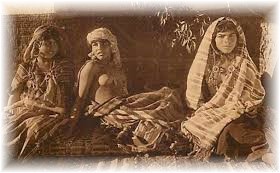
White Slavery and The Dark Continent: Lady Florence Baker, 1841-1916
A European orphaned at four years old, abducted into an Ottoman harem, and raised to become a concubine, Barbara Maria Szasz stood at a white slave auction, ordered to turn so that men could look at the round of her buttocks, the shape of her breasts, the dimple of her cheek, the depth of her eyes. Renamed Florenz, at fourteen she was a fetching prize for the highest bidder, the Pasha of Viddin. She would lead a comfortable life as a toy for his nightly visits until her breasts began to sag and her cheeks wrinkled. After that she would train other maidens to become good concubines, living and dying within the walls of the harem.
That might have happened had Sam Baker, a wealthy English adventurer, not been at the auction. Broken-nosed, bushy-bearded, he had accompanied Duleep Singh. Singh was the maharajah who so desperately wanted Queen Victoria to make him a prince that he gave up the entire Punjab region and the hugely brilliant Kohinoor diamond for the title. Baker, his minder, had been on a Danube hunting trip with him.
Baker caught her eye, and couldn't turn away. He wanted her, and badly. She was very beautiful and she appeared very angry. He was attracted to her but was also moved by compassion and empathy for her plight. Unwilling or unable to outbid the Pasha, he undertook a very dangerous adventure. He stole her from the auction and smuggled her out of Ottoman territory into the Austro-Hungarian Empire. Their chemistry was immediate and they became intimate during the journey, deepening over the years into lasting love.
A widower, Baker left his young family in England with his sister while he traveled the world. This was the age of Victorian prudery, when table legs were covered because they suggested human anatomy. Rather than return home with his young lover, Baker took her, at sixteen, with him into the uncharted regions of the Dark Continent, into areas of Africa far beyond maps. In Medieval times, such places were inscribed on maps by the warning, Here be dragons. With a safari, bearers, scouts, and hunters, they trekked over savannahs, and through forests to discover the source of the Nile. Baker also hoped to rescue John Speke and James Grant, lost somewhere in a region that remained a question mark for the European imagination.
The journey down the Nile took four years. Fluent in Arabic, she often acted as interpreter. He and his young companion witnessed female circumcision, negotiated with hostile tribes, and nearly died of fever. In fact, they found Speke and Grant, and discovered the source of the Nile, which they named Lake Albert, as companion to Lake Victoria, christened by Speke. They also discovered Murchison Falls. In their story, we understand that Baker was not only attracted to his young lover. He had seen her anger but also rescued her because he abhorred slavery. In their travels they entered markets in which slaves were bartered for elephant tusks. Baker swore that the Nile would be free of slavers and slaves.
Back in England, they found their welcome less than gracious, especially for Florence, who was shunned as a loose woman. Queen Victoria refused to receive her in court, although Prince Bertie, Baker's friend, observed regularly to the queen that Florence was quite ladylike.
On the other hand, Sam was awarded a gold medal from the Royal Geographical Society and a knighthood from the Queen. This, along with their marriage, made them more acceptable. As Sir Sam Baker and Lady Florence Baker, they eventually moved in the circles of marquesses, dukes, and the Prince and Princess of Wales. Victoria remained aloof.
They should have had no further needs; respectable society was theirs. They had wealth, privilege, and position, but this was not enough. Baker received a commission from the Viceroy of Egypt. It was to exterminate the black slave trade in Africa, a trade that fed the Ottoman Empire. Despite a small army and navy, Florence and Sam almost lost their lives this time. During his first adventure, Sam Baker had sworn against slavery as his enemy, one that he would wipe out. It was an enemy, though, that almost vanquished them both. This journey was not the same as it was for her at sixteen. Dangerous, the adventure left her frightened and deceived by native tribesmen as they fought with the Bakers and one another. She became disillusioned and never returned to Africa.
Lady Florence arrived in London by a rather incredible series of events. Her father was a Transylvanian officer who wound up on the wrong side of a revolution. Born into a comfortable family in 1841, she was orphaned and forced from her home in Transylvania during the 1848 Hungarian Revolution and then was abducted into a harem from a refugee camp. Nobody could have predicted the destiny that awaited her.
 |
| A Somewhat Older Lady Baker |
Pat Shipman has written a fine, and well-researched account of Lady Florence's life in To The Heart of The Nile.



